


The young Uzbek team winning this year’s Olympiad came as a pleasant surprise, but it is not an isolated example in the recent shift of world chess power. Uzbek boys, Kazakh girls, Azeri youth, Chinese, Indian and Iranian young phenoms ever more frequently lit the chess sky. What do their countries have in common? They all once lined the Silk Road. More indicatively, they all suffered the yoke under the Mongol’s rule: first the Genghis Khan’s Mongol Empire (1206 - 1368), and soon after its collapse, the Timurid Empire (1370 - 1405), ruled by yet another Mongol, Timur the Great.
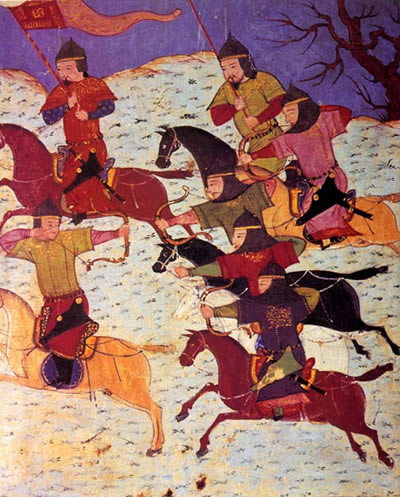
Mongol Cavalrymen, from a 14th-century manuscript | Photo: Mongols in World History
In contrast to their savagery, the Mongols appreciated and cultivated arts, architecture, literature and the sciences. And also, chess.
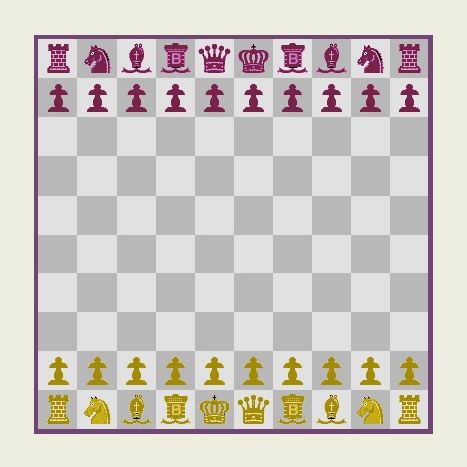
Hiashatar, or Mongolian Grand Chess, a medieval chess variant with an additional piece, the Bodyguard (also called ‘Senior Adviser’ or ‘Warrior’) | Photo: MLWI.Magix
Mongolian chess, also known as Shatar, an old variant with the same number of pieces as classical chess but a different set of rules, today is still played in north China’s Inner Mongolia Autonomous Region as well as in Mongolia proper.

A Mongolian chess set made of felt that is traditioanally produced by the nomads of Mongolia | Photo: AKIpress

Purev Jigjidsuren, 75-year-old International Master and FIDE Trainer, a former coach of the Mongolian national team, says that “chess in Mongolia is as traditional as herding and wrestling” | Source: Bne Intellinews
A huge, intensified movement and interest in chess have gripped the historic Mongol Empire regions recently. Their governments get directly involved, providing moral and financial support to chess players. The presidents personally meet the ‘conquerors’ or send personal congratulatory letters after each international success. Strong trainers are employed, and good results that raise the country’s reputation are awarded with encouraging gifts including cars and flats.
In this regard, Uzbekistan excels and, no wonder, it yields astonishing results. In par with their invading the winners’ podiums on the international scene, a close cooperation has been established with FIDE — and important FIDE competitions ‘moved’ to these shores.

Ichan-Kala, the old part of Khiva, hosted the Women’s Candidates Tournament (Pool B) | Photo: Uzbekistan Travel

The Uzbek wonder boys (left to right): GM Shamsiddin Vokhidov, GM Nodirbek Abdusattorov, GM Jakhongir Vakhidov, GM Nodirbek Yakubboev and GM Javokhir Sindarov | Photo: Uzbekistan Chess Federation
The Uzbek President, Shavkat Mirziyoyev, held a special reception for his country’s Olympians and personally congratulated each one of them.
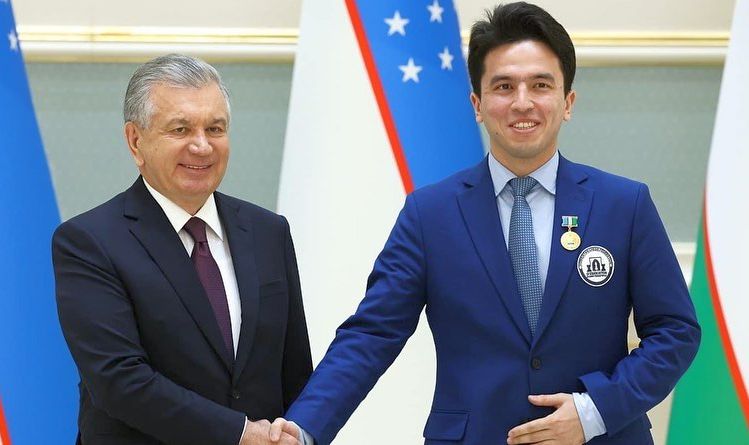
Shavkat Mirziyoyev congratulates Jakhongir Vakhidov, a member of the Olympic team who also won individual gold on the fourth board | Photo: Uzbek Chess Federation

The most successful of the Uzbek team, Nodirbeck Abdusattorov, has paved a solo career with resounding success: winner of the World Rapid Chess Championship 2021, the youngest ever Rapid World Champion at 17 years, broke Magnus Carlsen’s record, who was 18 when he won it, in 2009. The most famous win to his credit is the win over Magnus in the same championship. He also won the games against two World Champion’s challengers: Caruana and Nepomniachtchi.
Abdusattorov knocked Anish Giri out of the 2021 World Cup.
In the FIDE rating list of May 2015, at eleven years of age, he set a record: the youngest player to enter the top 100 among junior players.
At the Olympiad, he won an individual silver medal on board 1, tied with the gold winner, Gukesh, from India. His tournament performance rating was 2803.
The famous five from Uzbekistan missed for a whisker the first place at the recent World Team Championship. The gong went to their young counterparts from China: Lu Shanglei, Xu Xiangyu, Bai Jinshi and Li Di. The Chinese team won a fine victory, even though their country’s best players were not participating. But that only shows the tremendous strength China commands on the chess scene.

China vs Uzbekistan at the 2022 World Team Championship
From 1950 to 1991, for 41 years, the Women’s World Championship title belonged to a player from the Soviet Union. The pattern was broken in 1991 when Chinese Xie Jun became world champion. Since then, out of the 19 world champion matches, concluding with the 2020 match, 14 were won by a Chinese player. The recently finished Women’s Candidates tournament showed once again that Chinese women reign supreme. Three Chinese ladies will be battling for the world champion title. Ju Wenjun, the reigning world champion, will be challenged by either Lei Tingjie or Tan Zhongyi, winners of each of the two pools.

Ju Wenjun, Lei Tingjie and Tan Zhongyi

Praggnanandhaa R, Gukesh D, Erigaisi Arjun and Nihal Sarin, just a small part of the Indian squad of prodigies that have become a constant fixture on the international chess scene

The Kazakh Bibisara Assaubayeva’s 2021 double success: first place at the Women’s World Blitz, second place at the Women’s World Rapid
Bibisara has entered the Guinness World Records book as the youngest world blitz champion among women.

Azerbaijan’s double triumph at the 2022 World Juniors’ Championship: winner of the open, IM Abdulla Gadimbayli, winner of the women’s section, WGM Govhar Beydullayeva | Photo: FIDE
Zhansaya Abdumalik from Kazakhstan made waves with her exceptional performance at the Women’s Grand Prix in Gibraltar 2021. She was joined on the podium by the Azeri Gunay Mammadzada, who won bronze. At the 2022 European Individual Women’s Championship, Mammadzada won silver, while Ulviyya Fataliyeva, another Azeri, von bronze.
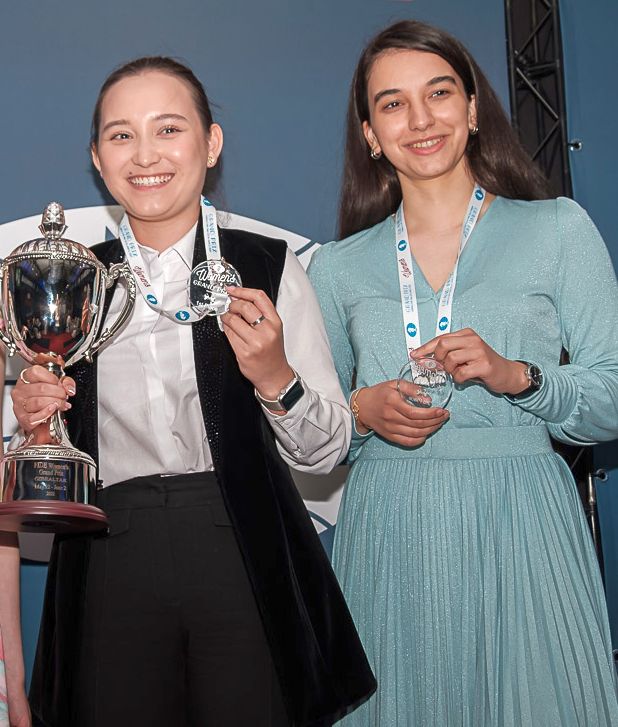
Zhansaya Abdumalik and Gunay Mammadzada at the 2021 Women’s Grand Prix in Gibraltar
Before the start of the Olympiad, the Kazakh president, Kassym-Zhomart Tokayev, invited the women Olympians to a well-wishing and encouragement reception. Indeed, they brought bronze back home, for the first time in the Kazakh chess history, only narrowly missing a much higher placement.

At the reception with the President Tokaev, before the start of the Olympiad: Meruert Kamalidenova, Zhansaya Abdumalik, Dinara Saduakasova, Guliskhan Nakhbayeva and Bibisara Assaubayeva
At this year’s 44th World Chess Olympiad, the Mongolian women’s team, composed of Enkhtuul Altan-Ulzii, Bayarmaa Bayarjargal, Munkhzul Turmunkh and Mungunzul Bat-Erdene, ranked 28th, caused a shock in the third round, defeating the seventh-ranked Americans 3:1. 17-year-old Mungunzul Bat-Erdene, won Mongolia’s first-ever individual gold medal, on the fourth board.

B. Mungunzul receiving a special award from G. Zandanshatar, the Speaker of the Parliament, at a reception for the Mongolian Olympic team members | Photo: Gogo
The 2022 World Amateur Championships were dominated by Mongolian and Kazakh players.
Three gold medals went to Mongolians: in the Women U1700, Margadgua Erdenebayar became the champion with a round to spare, scoring 8½/9; 13-year-old Sodbilegt Naranbold was the outright winner in the Open U2000 with a perfect score of 9/9; Tugulder Soninbayar won first place in the Open U1700 with 7½/9.
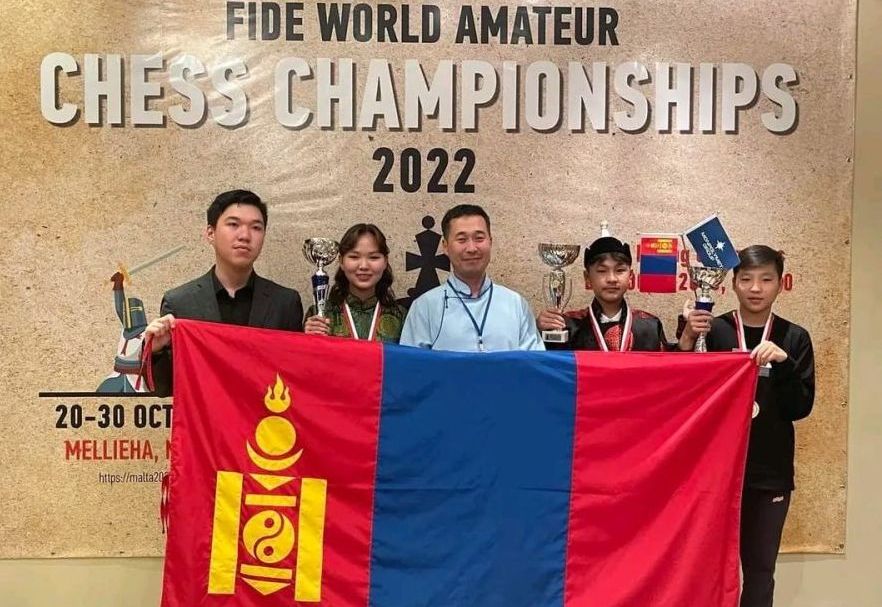
Flying the Mongolian flag: Margadgua Erdenebayar, Tuguldur Soninbayar, and Sodbilegt Naranbold (at the far right)
Actually, Mongolians have marked their winning streak at the World Amateur Competition starting from 2011 when GM S. Bilguun became the first Mongolian winner; WFM B. Anu won the gold medal in 2011, WFM B. Yanjinlham in 2013, FM G. Monkhbayar in 2014, FM E. Khulan in 2016, WIM B. Bayarmaa in 2017 and 2018, and finally WFM B. Khaliun and FM B. Amarsaikhan won in 2019.
This round-up of current successful players with Mongol - Silk Road links is certainly not exhausted, but the picture would not be complete without yet another young phenom: GM Alireza Firouzja, Iranian by birth, now playing for the French Federation, the strongest junior player in the world and the youngest ever to reach a 2800 rating.

Alireza Firouzja, winner of the 2022 Grand Chess Tour, the youngest ever winner of a Grand Chess Tour event | Photo: Lennart Ootes
Today's countries that constituted the ancient Silk Road Region and largely the Mongol and later the Timurid Empire include Azerbaijan, China, Korea, Egypt, Indonesia, Iran, Iraq, Japan, Kazakhstan, Kyrgyzstan, Malaysia, Mongolia, Pakistan, Sri Lanka, Russia, Ukraine, Syria, Turkey and all five ‘Stans’ om Central Asia: Kazakhstan, Kyrgyzstan, Tajikistan, Turkmenistan, and Uzbekistan (-stan is a Persian suffix meaning ‘land of’).
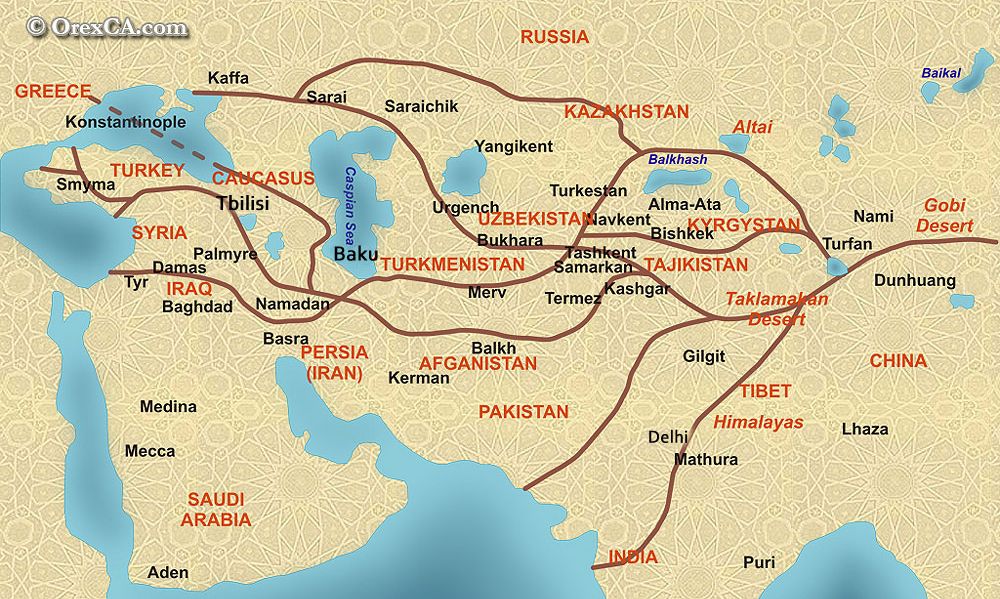
Modern-day countries that were connected by the Silk Road | Photo: Oriental Express Caucasus & Central Asia
| Advertising |